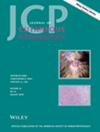伴有血管异常的巨大先天性纤维结缔组织痣。
IF 1.6
4区 医学
Q3 DERMATOLOGY
引用次数: 0
摘要
我们描述了一种不寻常的合并症,即出生时就已存在的成纤维结缔组织痣(FCTN)和潜在的血管异常。总的来说,病变表现为腹股沟区域至右大腿三分之一处的一个紫褐色大肿块,在出生后的头三个月部分自发消退。所观察到的 FCTN 有几个不同寻常的特点:先天性、体积大、位于下肢。最后,这也是第一例与血管畸形同时出现的 FCTN。本文章由计算机程序翻译,如有差异,请以英文原文为准。
Giant congenital fibroblastic connective tissue nevus associated with vascular anomalies
We described an unusual combination of fibroblastic connective nevus (FCTN) already present at birth with underlying vascular anomalies. Overall, the lesion appeared as a large purplish-brown mass in the groin region up to the third of the right thigh, with partial spontaneous regression during the first three months of life. The FCTN observed exhibited several unusual characteristics: it was congenital, large in size, and located in the lower limbs. Finally, it represented the first case described in which an FCTN arose in association with vascular anomalies.
求助全文
通过发布文献求助,成功后即可免费获取论文全文。
去求助
来源期刊
CiteScore
3.20
自引率
5.90%
发文量
174
审稿时长
3-8 weeks
期刊介绍:
Journal of Cutaneous Pathology publishes manuscripts broadly relevant to diseases of the skin and mucosae, with the aims of advancing scientific knowledge regarding dermatopathology and enhancing the communication between clinical practitioners and research scientists. Original scientific manuscripts on diagnostic and experimental cutaneous pathology are especially desirable. Timely, pertinent review articles also will be given high priority. Manuscripts based on light, fluorescence, and electron microscopy, histochemistry, immunology, molecular biology, and genetics, as well as allied sciences, are all welcome, provided their principal focus is on cutaneous pathology. Publication time will be kept as short as possible, ensuring that articles will be quickly available to all interested in this speciality.

 求助内容:
求助内容: 应助结果提醒方式:
应助结果提醒方式:


